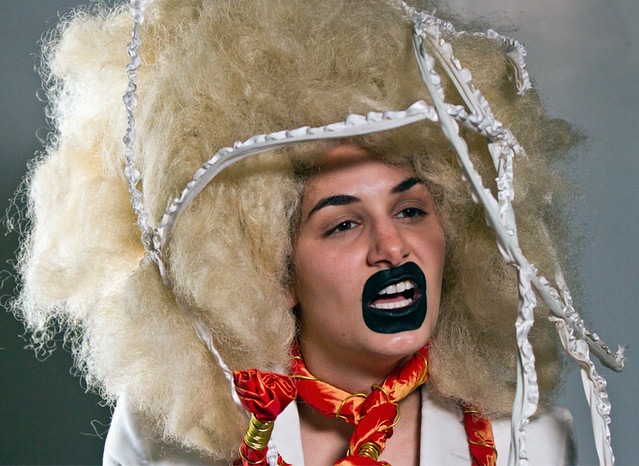Art museum presents 'Camera Lucida' showcasing eight new media artists from around the world
Article body
It's as clear as the image on your high-definition TV: Whether binge-watching the hottest show, sharing smartphone videos and even now as you scroll the Auburn homepage, screen experiences are a part of our daily lives. But perhaps less common is the use of this technology as an independent art form.
"In the same way artists in previous eras used oil paint, printing and other media, artists today claim video for new visual and conceptual purposes," said Dennis Harper, curator of collections and exhibitions at Jule Collins Smith Museum of Fine Art, Auburn University. The museum has opened its first dedicated exhibition to video art, "Camera Lucida," to run through Jan. 7, 2017, in the Bill L. Harbert Gallery and Gallery C.
What is "Camera Lucida?"
Before the modern photographic camera, an ancient device known as the camera obscura captured images of the outside world and projected the images into an unlit interior space. Camera lucida translates as an illuminated space.
"We borrow the latter term for the title of this exhibition to characterize the modern, luminous and unrestrained form of image-making that is demonstrated in the exhibition," Harper said. "Video has developed into a comfortable, accessible and—to a growing number of users—preferred medium for both consumption and creation. Many critics consider it to be this generation's quintessential format for expression. While the technology is rooted in the 1920s, video art dates back 50 years, ranging from documentary formats to game-playing interactions. This exhibition highlights how age-old intentions find new purpose in new applications."
"Camera Lucida" features eight new media artists from around the world: Jay Bolotin, Rob Carter, Joe Hamilton, Yeon Jin Kim, LigoranoReese, Jillian Mayer, Rosa Menkman and Rick Silva. Harper says the artists offer fresh perspectives on enduring concerns and new issues.
Bringing the artists to campus
As a part of the FILM@JCSM series organized by the museum and the College of Liberal Arts, some of the "Camera Lucida" artists are coming to campus to meet with students, faculty and the community. On Thursday, Sept. 29, Carter will speak, and on Thursday, Nov. 3, Silva will present. All FILM@JCSM programs are held in the museum auditorium at 5 p.m. Admission is free.
Harper says Mayer shifts among genres and personas as she takes on the clichéd memes, cultural affectations, lowbrow entertainment, social media confessionals and online cons that occupy a large portion of her generation's digitally augmented experience. "Mayer examines technology's shortcomings and filters its promises of a bright future through the dual lenses of parody and sincerity," Harper said. "How one crafts an identity within the overlap of virtual and physical environments is a frequent focus of her art."
Carter uses stop motion animation to render fictional yet conceivable transformations of the landscape through mankind's propensity for building. "Metropolis" depicts a similar metamorphosis of rural, 18th-century Charlotte, North Carolina, into a futuristic urban conglomeration of skyscrapers and sports arenas. "Created by video-recording printed images on paper, cut and folded progressively into elaborate compositions, Carter's videos comment on the politics of hubris and humanity's relationship with the natural world," Harper said.
Silva creates videos and other moving digital art using imaging software, often designed for exclusive existence on the web, where users may freely access them on personal devices. "The Silva Field Guide to Birds of a Parallel Future" was originally conceived as 18 separate modules viewed online. Harper says that for this exhibition, the artist has configured them for a more immersive and simultaneous viewing experience streaming on a grid of wall-mounted monitors.
Plan your visit
Other exhibitions on view include "Out of the Box: A Juried Outdoor Sculpture Exhibition," "Call and Response," featuring artists from the university community alongside art and natural history collections, plus selections from the museum's permanent collection. The museum is open Tuesday through Saturday, from 10 a.m. to 4:30 p.m., with extended hours on Thursday until 8 p.m., and Sundays 1 to 4 p.m. On Thursdays, the Museum Café is open from 5 to 8 p.m. with live music. Admission to the museum is free; a $5 donation is appreciated. The exhibition has been made possible by grants from the Alabama State Council on the Arts and the National Endowment for the Arts. FILM@JCSM is co-sponsored by the Alabama Humanities Foundation, a state program of the National Endowment for the Humanities. For more information, visit www.jcsm.auburn.edu or call 334-844-1484.
Related Media
Media interested in this story can contact Communications Director Preston Sparks at (334) 844-9999 or preston.sparks@auburn.edu.
Auburn University is a nationally ranked land grant institution recognized for its commitment to world-class scholarship, interdisciplinary research with an elite, top-tier Carnegie R1 classification, life-changing outreach with Carnegie’s Community Engagement designation and an undergraduate education experience second to none. Auburn is home to more than 30,000 students, and its faculty and research partners collaborate to develop and deliver meaningful scholarship, science and technology-based advancements that meet pressing regional, national and global needs. Auburn’s commitment to active student engagement, professional success and public/private partnership drives a growing reputation for outreach and extension that delivers broad economic, health and societal impact.







